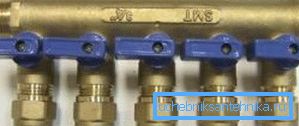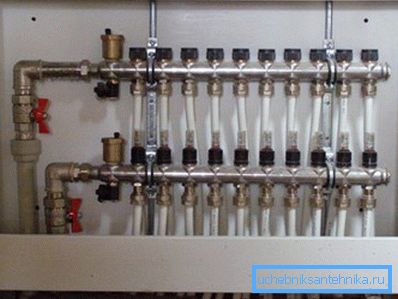What is a collector for plumbing
To begin, let's clarify what a water manifold is - a technical tubular part that can mix different liquids (according to molecular composition or temperature) or distribute it through several channels simultaneously. In our case, it can be a mixer, a tee, a quadrangle or a comb for distributing heating or water supply pipes.
We will pay more attention to the latest version - find out how it connects, and see a video demonstration in this article.

Installation of collectors
Note. By and large, the installation of collectors, as such, does not exist at all, since it is just an intermediate adapter that facilitates the facilitated transfer of fluid into other channels. The entire installation of such a device is usually considered in conjunction with other plumbing fixtures and systems.
Species

- The most well-known form of a collector for an ordinary user with sanitary units is a sink or bath mixer, that is, built in a bathroom and laid on the wall (there are also wall recessed options). This mechanism may have valves in the form of a crane-box (two-valve and two-lever models), or in the form of a cartridge or a ball (single-lever or joystick models).
- In any of the types of valves, one principle of water intake is in effect - it comes from two sources (hot and cold), and comes out for consumption through one channel, called the spout. The price of such devices can vary greatly from each other, depending on the quality and decoration.

- The simplest of all water collectors is a sanitary tee for pipes, which, in essence, is a water distribution unit - the supply goes through one channel, and the distribution goes through two. Such devices are constantly used not only in the water supply, but also in the sewage system (fan tees), as well as they are used to transport and distribute a wide variety of liquids and gases. In the water supply they are made of steel, brass, copper, polypropylene, cross-linked polyethylene and polybutylene.

- And, finally, the most well-known plumber type of collector is a comb, which is used for water assemblies when installing a water heated floor, or it may be the distribution of fluid for radiators to different wings of the building. In most cases, it is sold with valves, as you see in the photo above, but it can also be supplied without it - then the valves have to be installed independently.
- As a rule, combs of this type are made of brass, although they can also be made of copper, steel, and even silumin, although it is better not to use the latter option. The number of taps at such a device may be different, ranging from three to infinity, that is, you can connect collectors that have 10 or more outlets, if there is a need.
Heated floor collector

The distribution node for water analysis in heating instruction allows you to install not only in the niche, but outside, if there is a special room for this - a boiler room, where such a system will not interfere with anyone. But, first of all, let's understand the essence, that is, in principle, connect the heating system through the collector and find out how it works.
Two circuits always run from any heating boiler - one for supplying hot water, and the other to return the already cooled coolant, therefore, to install a water heated floor, you will also need two combs - the inlet and the outlet.
So, you are installing a hot-water boiler, from which the heating circuits are separated, but in this case the supply pipe and return pipe goes to the water dispenser with combs. So, one collector is installed for supply, and for the return of the other, usually they are mounted one above the other, regardless of whether they are recessed into the wall or not.

As you can see in the upper photographs, the stop valves are located not only on the collector pipes, but also on the pipes connecting them with the heating boiler, and on the other side of each of them, the Mayevsky valve is usually screwed in to bleed air, which can always be in the system.
The number of nozzles depends on the number of water circuits, for example, you can install one distribution node on a house of 10 rooms, then you need combs with at least 10 taps, but there may be more than one circuit in one room, then the number of leads will need to be increased .
One floor water circuit, whether it is made of cross-linked polyethylene or metal-reinforced plastic, should not have joints closed by a cement-sand screed - otherwise you risk the length of the service life of the heating system.
In cases where the room is large and you do not fit in the dimensions of one pipe coil, it is best to divide the room along the wings, so for one such area there may be two, three or even four wings, which, in turn, will be reflect on the length of the collector.

But it’s extremely impractical to install one water outlet for a large house - in this case, you will have to lay extra pipes, and at the very beginning this can be a rather impressive accumulation of circuits, which is not very convenient for installation.
It is much easier to make one water-knot into two or three rooms, as shown in the upper photo, then you will have to lay fewer pipes in one place, which entails an increase in the passage through the walls. The wiring of the supply and return circuits in such cases is usually carried out with polypropylene, which passes to the brass manifold through a threaded fitting.
Note. Practice shows that the installation of a water heated floor is much more profitable to produce not with cross-linked polyethylene, but with metal-based laminate - the quality of heating and its operating life does not change, while the cost decreases. In addition, there are always collectors on sale, the branch pipes of which are equipped with end fittings for switching to a metal-plastic pipe.
Conclusion
In conclusion, I would like to note that you can use any of the collectors by connecting it to the water pipes with your own hands - this is not at all difficult. Even long combs for installing a warm floor, in fact, are not much different from the usual tee.